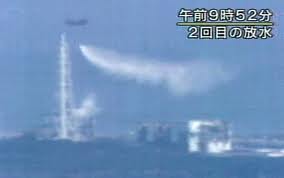
 VOA is saying that today, Friday, officials have raised the severity rating of Fukushima nuclear disaster from 4 to 5 on the 7-point international nuclear event scale. The International Nuclear and Radiological Event Scale (INES) was introduced in 1990 by the International Atomic Energy Agency (IAEA) in order to enable prompt communication of safety significance information in case of nuclear accidents. (Wikipedia) Three Mile Island accident in 1979 was rated 5 and the Chernobyl disaster in 1986 was rated 7.
VOA is saying that today, Friday, officials have raised the severity rating of Fukushima nuclear disaster from 4 to 5 on the 7-point international nuclear event scale. The International Nuclear and Radiological Event Scale (INES) was introduced in 1990 by the International Atomic Energy Agency (IAEA) in order to enable prompt communication of safety significance information in case of nuclear accidents. (Wikipedia) Three Mile Island accident in 1979 was rated 5 and the Chernobyl disaster in 1986 was rated 7.
Wikipedia describes level 5 as:
Level 5: Accident with wider consequences
- Impact on People and Environment
- Limited release of radioactive material likely to require implementation of some planned countermeasures.
- Several deaths from radiation.
Impact on Radiological Barriers and Control
- Severe damage to reactor core.
- Release of large quantities of radioactive material within an installation with a high probability of significant public exposure. This could arise from a major criticality accident or fire.
Thursday
There was limited success using helicopters to dump water on the reactors. Much was dispersed in the wind and didn’t hit the target. Apparently in the evening, pumper trucks similar to those used at airports were being used to spray water. 30 tons of water was put on reactor #3. Work continued to try and connect outside power lines to Fukushima in an attempt to bring the plants own cooling systems back on-line.
Friday
Spraying continued. Power had not yet been restored to the plant. At 6pm local time, the severity level was raised from 4 to 5.
A reminder of the dangers of nuclear power
An energy source which produces electricity but doesn’t pollute the atmosphere like coal or oil. An energy source which doesn’t involve flooding wide expanses of territory. An energy source which doesn’t necessary disturb the landscape as with windmill farms. Seems like a dream and it is as there is a reality about nuclear energy as a silent, invisible killer.
The 1979 American thriller The China Syndrome painted a scary but plausible portrait of nuclear energy run amuck. In a telling twist of fate, the film was released just 12 days before the Three Mile Island accident.
U.S. President Barack Obama said Thursday he had ordered a comprehensive review of U.S. nuclear facilities and said radiation from a tsunami-struck power plant in Japan posed a “substantial risk” to people nearby. (The Montreal Gazette)
Germany’s environment minister has called for drastic safety measures to be implemented at the country’s nuclear power plants, which could make them not viable commercially, coalition sources said on Friday. (Reuters)
But…
The Washington Post: commentary: Don’t Write Off Nuclear Energy Just Yet
Japan’s nuclear catastrophe has caused a huge rethink about atomic power worldwide.
…
But at a time when oil prices have been pushing higher and renewable sources of electricity generation either rely on large dams or are intermittent and very expensive—like wind and wave power—that nuclear rethink may not last long.
…
The Fukushima Daiichi disaster won’t turn into a Chernobyl.
…
compared with the routine disasters in the coal mining industry. For instance, the Macro Man blog points out that 2,433 people were killed in Chinese coal mines last year and even this was down substantially from an annual average of 7,619 during the late 1990s. That’s not to mention the wider health costs and other externalities of burning the stuff. As George Monbiot’s blog in The Guardian pointed out Wednesday, coal fired power stations carry into the surrounding environment “100 times more radiation than a nuclear plant producing the same amount of energy.”
Ontario’s Pickering leaks radioactive water
The CBC has reported that on Monday, March 14, 2011, a pump seal failed and the Pickering Plant dumped 73,000 litres of what is being called “demineralized water” into Lake Ontario.
Andrew Nichols of CBC News reported about the leak on Wednesday afternoon and said he spoke to an Ontario Power Generation spokesperson who told him the risk is minimal but that such leaks are not supposed to occur.
Nichols reports speaking with Gordon Edwards of the Canadian Coalition of Nuclear Responsibility who apparently was outraged at the public statement issued about the leak. He pointed out that Lake Ontario is the source of drinking water for millions of people and the industry says that leak is of a negligible risk.
The Associated Press – Mar 18/2011
Japan Raises Nuclear Severity Level
Japan’s nuclear safety agency raised the severity rating of the country’s nuclear crisis from Level 4 to Level 5 on a 7-level international scale, putting it on par with the Three Mile Island accident in Pennsylvania in 1979. (March 18)
BBC News – Mar 12/2011
Exodus from Japan nuclear plant BBC
[An interesting journey by car which shows the destruction of the quake and tsunami]
http://www.youtube.com/watch?v=vk1UiqcWTVc
CNN has reported the official count of the number of dead has reached 7,000 with another ten thousand missing.
Click HERE to read more from William Belle
Article viewed at: Oye! Times at www.oyetimes.com

Be the first to comment